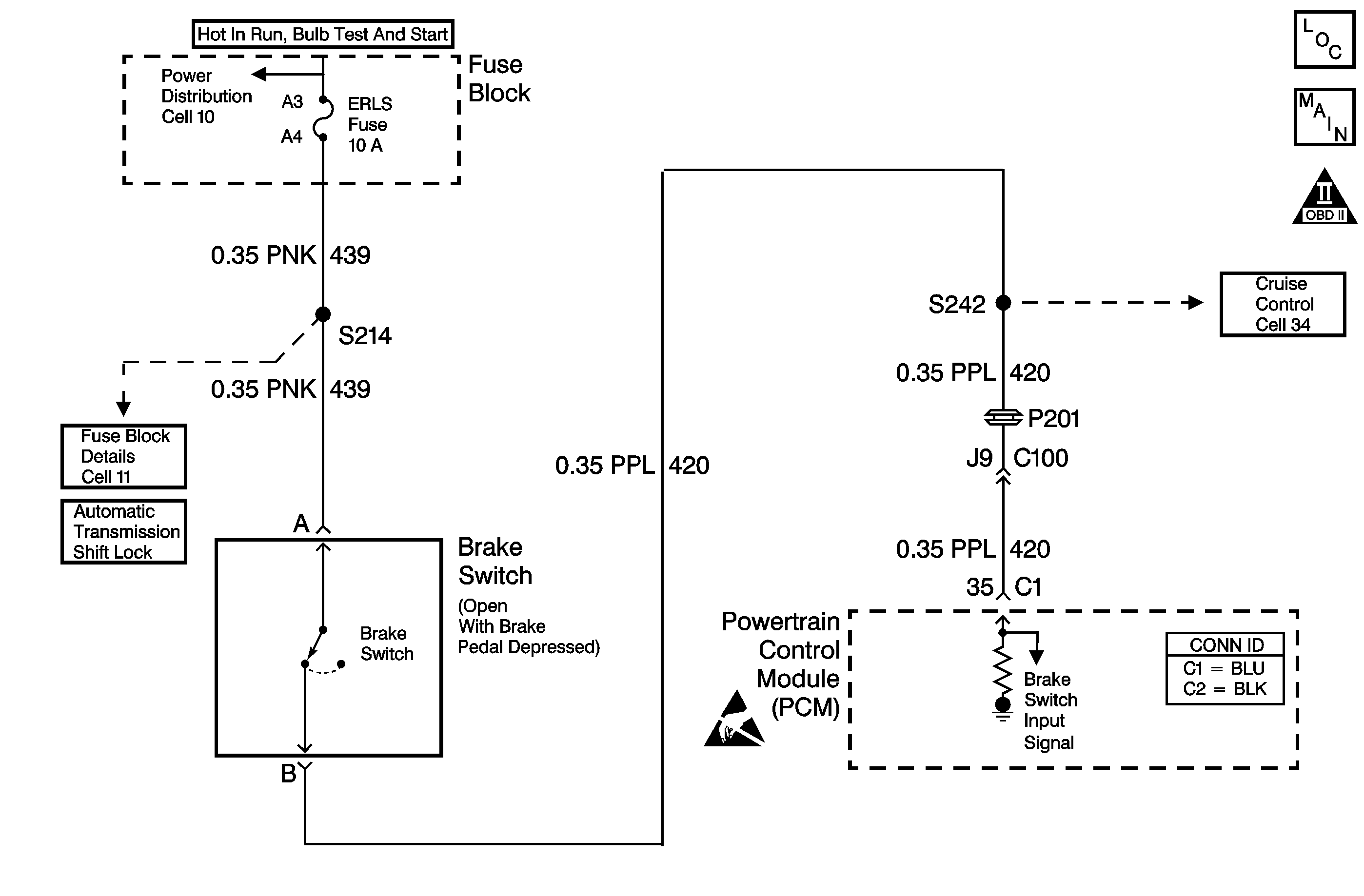
Circuit Description
The brake switch indicates brake pedal status to the powertrain control module (PCM). The normally-closed switch supplies battery voltage on circuit 420 to the PCM. Applying the brake pedal opens the brake switch, interrupting voltage to the PCM. While the brake pedal is not applied, the PCM receives constant voltage. If the PCM receives 0 volts at the brake switch input with the torque converter clutch (TCC) engaged, the PCM de-energizes the torque converter clutch solenoid valve (TCC solenoid valve).
When the PCM detects a closed brake switch circuit (12 volts, high input) during decelerations, then DTC P0724 sets. DTC P0724 is a type C DTC.
Conditions for Running the DTC
The ignition is in the ON position.
Conditions for Setting the DTC
DTC P0724 sets if the PCM detects a closed brake switch or circuit (12 volts) during vehicle deceleration and the following conditions occur eight consecutive times:
| • | The vehicle speed is greater than 32 km/h (20 mph) for 6 seconds |
| • | then the vehicle speed is 8-32 km/h (5-20 mph) for 3 seconds |
| • | then the vehicle speed remains less than 8 km/h (5 mph). |
Action Taken When the DTC Sets
| • | The PCM does not illuminate the malfunction indicator lamp (MIL). |
| • | The PCM records the operating conditions when the Conditions for Setting the DTC are met. The PCM stores this information as Failure Records. |
| • | The PCM stores DTC P0724 in PCM history. |
Conditions for Clearing the DTC
| • | A scan tool can clear the DTC. |
| • | The PCM clears the DTC from PCM history if the vehicle completes 40 warm-up cycles without a non-emission related diagnostic fault occurring. |
Diagnostic Aids
| • | Inspect the brake switch for proper adjustment. |
| • | Inspect the connectors at the PCM, the brake switch and all other circuit connecting points for an intermittent condition. Refer to Testing for Intermittent Conditions and Poor Connections in Wiring Systems. |
| • | Inspect the circuit wiring for an intermittent condition. Refer to Testing for Electrical Intermittents in Wiring Systems. |
Test Description
The numbers below refer to the step numbers on the diagnostic table.
-
If you disconnect the brake switch connector and observe the Scan Tool brake switch status change, then a brake switch problem is the only possible cause of the DTC.
-
An unchanging brake switch status (Closed) in step 2 indicates a possible short to power in the input circuit.
-
If the brake switch is properly adjusted, then you must replace the brake switch.
-
Replace the PCM only after you have completed the preceding diagnostic steps.
Step | Action | Value(s) | Yes | No | ||||
|---|---|---|---|---|---|---|---|---|
1 | Did you perform the Powertrain Diagnostic System Check ? | -- | ||||||
Important: Before clearing the DTC, use the Scan Tool in order to record the Failure Records. Using the Clear Info function erases the Failure Records from the PCM. Did the Brake Switch status change from Closed to Open? | -- | |||||||
|
Important:: The condition that affects this circuit may exist in other connecting branches of the circuit. Refer to Power Distribution Schematics for complete circuit distribution. Test the input circuit (CKT 420) of the brake switch for a short to power. Refer to Circuit Testing and Wiring Repairs in Wiring Systems. Did you find and correct the condition? | -- | |||||||
Replace the brake switch. Refer to Stop Lamp Switch Replacement in Hydraulic Brakes. Did you complete the replacement ? | -- | -- | ||||||
Replace the PCM. Refer to Powertrain Control Module Replacement/Programming in Engine Controls. Did you complete the replacement? | -- | -- | ||||||
6 | Perform the following procedure in order to verify the repair:
Has the test run and passed? | -- | System OK |
